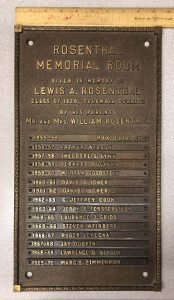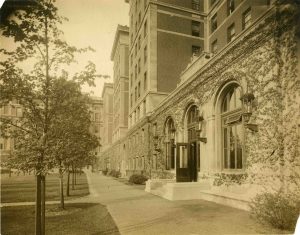Have you ever wondered who else lived in “your” dorm room? Some Columbia students have been visited by returning alumni (see Art Garfunkle); others could search student directories and other sources available at the University Archives. But for a select few, from around the 1930s to the 1970s, there was a plaque right in their room with the names of the previous occupants. “Prize rooms” or scholarship rooms were once a regular feature on the Morningside Heights campus.

At the University Archives, we recently received a 9½” by 17” bronze plaque that used to hang in the Lewis A. Rosenthal Memorial Room, otherwise known as 803 Livingston Hall (now Wallach). As the plaque states, Roger Lehecka lived in the room in 1966-1967. When we reached out to him asking about the prize room plaque, he told us that the room was “a double turned into a single for this purpose and it faced the campus.” The endowment covered his room fees (“The subsidy made a big difference to me.”) As he recalled “[t]he only downside to the room was that there was this plaque on the wall, but you got used to it.”
Columbia alumni classes celebrating anniversaries would regularly raise funds to offer a gift to University. While some of these gifts could be monuments or gates on the new Morningside Heights campus, a number of classes chose to endow dorm rooms and help a current student-in-need become a future alumnus. In 1917, for example, the 1892 alumni of the Schools of Arts and Mines (that is, Columbia College and Engineering) endowed two rooms on campus: 633 Hartley Hall for a senior in the College, and 431 Furnald Hall for a student in their last year at the School of Applied Science and Architecture, as it was then known. Similarly, in 1937, the School of Mines Class of 1887, celebrating their 50th Anniversary, endowed room 933 Livingston Hall (now Wallach). The endowment covered the student’s room fees but could also include the cost of maintenance, renovations and refurnishings, including new drapes and the bronze plaque with the names of the room occupants. (It’s worth pointing out that both of these alumni classes had attended Columbia when the campus was on 49th Street and Madison Avenue, that is, when there were no student dormitories.) These class gifts came from the alumni of the College, Engineering and even Journalism; from the Classes of 1884 to 1928; and there were as few as two and, at one point, as many as 13 prize rooms available a year.
Who got to live in these subsidized rooms? It depends on how the original gift was created. For some rooms, candidates or nominees were selected by the class officers (and later by members of the Committee on Scholarships). The “prize” winner would be voted on by his fellow class members. Yes, popular elections with the vote totals published in the student newspaper (see 1956 results here). For other rooms, such as the Class of 1924 room, the College would send the information about the nominees to the alumni class officers to vote on the most deserving candidate. The short bios included the student’s name, hometown, age, major, grade average, sports, prizes, activities, employment (candidates worked for their meals in dining halls, or worked the concessions stand at Baker Field) and family situation such as the number of siblings and the father’s employment (locomotive inspector, guard, draftsman, salesman, runs a garage). At a later point, some prize rooms were awarded to the students based on their participation in extracurricular service activities and/or sports teams.

Lewis A. Rosenthal was a member of the Columbia College Class of 1928. Rosenthal had enrolled at the Columbia Law School but he died of spinal meningitis at age 22 on August 4, 1930, a year short of graduation. In December 1951, his parents, William and Ida Rosenthal, endowed the room (and the accompanying plaque) in honor of their son, who “spent his life as a student.”* The Rosenthal room occupant Roger Lehecka went on to serve in the Office of the Dean of Students of Columbia College (1979-1998), including as Acting Dean of Columbia College (1989), and the Director of Alumni Programs and Special Adviser to the Dean (1998-2001).
* From the Alumni Federation’s death notification form, Historical Biographical Files (Box 267, folder 18), University Archives.